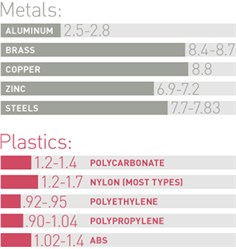01420 543007 (Option 1)
01420 543007 (Option 1)
Design Flexibility
Rediweld started as an injection moulder in Crawley in 1948. From 1996 until the present day Rediweld is now based in Alton, Hampshire and its operation has increased quite considerably.
Much of our focus has been in the aerospace business, converting exisiting metal parts to plastic.
Benefits that conversion to plastic can provide are:
• High tensile strength with proper structural design
• Reduced part weight
• Highly repeatable in processing (less scrap)
• Lower manufacturing costs
• Enhanced regulatory compliance
• Greater design flexibility (part consolidation)
• Lower packaging and shipping costs
• Up to six times longer tool life.
Current metal-to-plastic trends focus on reducing weight, improving strength and corrosion resistance, and consolidating multiple metal parts into one plastic part. Plastic parts can be just as tough as metal parts and achieve the same tight tolerances, with fewer secondary operations. In general, companies can expect to achieve an overall cost savings of 25% to 50% by converting to plastic parts.

A comparison of the specific gravity values of metals to plastics shows how dramatic the difference in weight can be.
Design Freedom
Converting to plastic parts gives customers more freedom in product design, including greater variety in material selection and being able to create more complex geometries. It is much easier to produce complex shapes out of plastic than metal, due to injection molds allowing for under-cuts, threads, ports, and tight tolerances allowing a net shape to be produced to the finish level specifications.
Plastic parts can actually be stronger than metal parts by using engineering-grade materials with proper structural design. The ability to mold in features for structural strength such as ribs, bosses, and gussets when the part is originally produced (instead of fastening, welding, and gluing afterwards) can increase the total strength of the assembled part as well as reduce additional costs.
Material Selection
Here at Rediweld we work closely with our clients using our experience in applications and processes, however our clients do reamain the design authority over what componds materials that they require.
The advances in Polymer science now allow us to compound a variety of plastic materials with specific fillers and reinforcements that provide a tremendous amount of structural integrity. Plastic can be as strong as metal with proper material selection paired with design optimization, and weigh far less.
One of the greatest advantages of plastics is the availability of more than 25,000 engineered materials for manufacturing applications. New, higher-performance blends and hybrids can also be custom-designed to meet very specific performance requirements.
Key considerations for type of plastic are:
• Crystalline vs. amorphous: evaluate requirements such as chemical resistance, impact, flow, processing, etc.
• Additives: additives will affect strength, stiffness, temperature performance, appearance, package requirements, and cost.
• Carbon and stainless steel fillers improve conductive and/or shielding properties.
• Lubricant fillers improve wear and friction properties.
• Mineral fillers improve electrical performance, weighted feel, sound dampening, and higher specific gravity and improve dimensional stability.
• Impact modifiers improve toughness.
Ref from article: by Mark Crawford, ASME.org